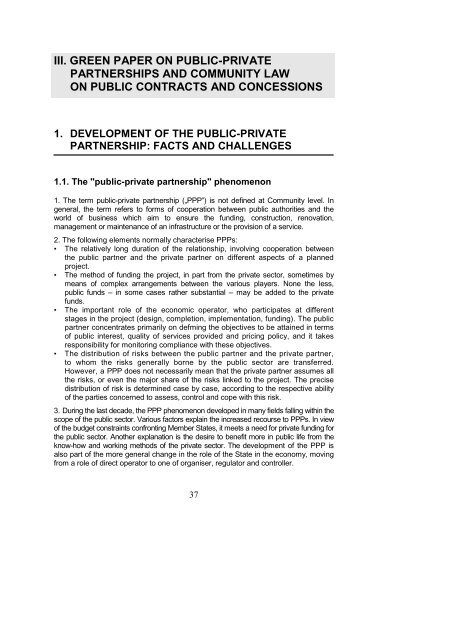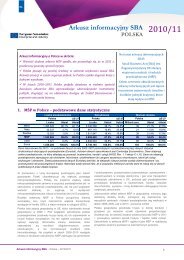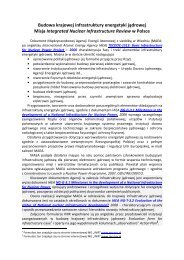Zielona księga w sprawie partnerstw publiczno-prywatnych i prawa ...
Zielona księga w sprawie partnerstw publiczno-prywatnych i prawa ...
Zielona księga w sprawie partnerstw publiczno-prywatnych i prawa ...
Create successful ePaper yourself
Turn your PDF publications into a flip-book with our unique Google optimized e-Paper software.
III. GREEN PAPER ON PUBLIC-PRIVATE<br />
PARTNERSHIPS AND COMMUNITY LAW<br />
ON PUBLIC CONTRACTS AND CONCESSIONS<br />
1. DEVELOPMENT OF THE PUBLIC-PRIVATE<br />
PARTNERSHIP: FACTS AND CHALLENGES<br />
1.1. The "public-private partnership" phenomenon<br />
1. The term public-private partnership („PPP”) is not defined at Community level. In<br />
general, the term refers to forms of cooperation between public authorities and the<br />
world of business which aim to ensure the funding, construction, renovation,<br />
management or maintenance of an infrastructure or the provision of a service.<br />
2. The following elements normally characterise PPPs:<br />
• The relatively long duration of the relationship, involving cooperation between<br />
the public partner and the private partner on different aspects of a planned<br />
project.<br />
The method of funding the project, in part from the private sector, sometimes by<br />
means of complex arrangements between the various players. None the less,<br />
public funds – in some cases rather substantial – may be added to the private<br />
funds.<br />
The important role of the economic operator, who participates at different<br />
stages in the project (design, completion, implementation, funding). The public<br />
partner concentrates primarily on defming the objectives to be attained in terms<br />
of public interest, quality of services provided and pricing policy, and it takes<br />
responsibility for monitoring compliance with these objectives.<br />
The distribution of risks between the public partner and the private partner,<br />
to whom the risks generally borne by the public sector are transferred.<br />
However, a PPP does not necessarily mean that the private partner assumes all<br />
the risks, or even the major share of the risks linked to the project. The precise<br />
distribution of risk is determined case by case, according to the respective ability<br />
of the parties concerned to assess, control and cope with this risk.<br />
3. During the last decade, the PPP phenomenon developed in many fields falling within the<br />
scope of the public sector. Various factors explain the increased recourse to PPPs. In view<br />
of the budget constraints confronting Member States, it meets a need for private funding for<br />
the public sector. Another explanation is the desire to benefit more in public life from the<br />
know-how and working methods of the private sector. The development of the PPP is<br />
also part of the more general change in the role of the State in the economy, moving<br />
from a role of direct operator to one of organiser, regulator and controller.<br />
37

















